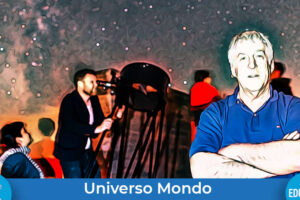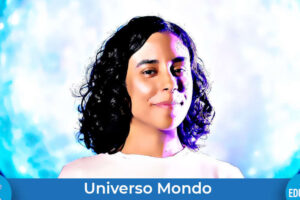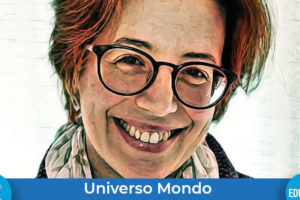Aggiornato il 28 Novembre 2024
Universe World is back and this time we travel all the way to Australia! Here, in Sydney, we meet Kirsten Banks, astrophysicist and science communicator who is best known on social media as @AstroKirsten, to discover together the ins and outs of the work of an astronomy content creator.

Your job sounds really exciting, tell us more about it…
I’m an astrophysicist and science communicator with a passion for making space and astronomy accessible to everyone. My current job revolves around creating engaging educational content for social media, speaking at events, and collaborating with organisations to promote STEM education. I also run my own business, AstroKirsten, where I share my love for the stars and encourage curiosity through science communication.
What led you to this very particular blend of science and communication?
My journey began with a fascination for space that led me to pursue a degree in astrophysics at University of New South Wales, where I completed my PhD studying evolved stars and the Milky Way’s history. Along the way, I discovered a love for science communication, which started as an astronomy guide at Sydney Observatory but grew into something much bigger. I realised that translating the complexity of astronomy into content that sparks curiosity was where I could make the most impact, and it eventually led me to my current role as a science communicator who focuses on educational video content.
You earned your PhD quite recently, only a few months ago. Why did you choose to focus on astronomy communication after that?
During my PhD, I found that explaining space science to others through educational video content was just as rewarding as researching it. Astronomy is awe-inspiring, and I wanted to share that excitement with as many people as possible. Science communication allows me to bridge the gap between complex concepts and the general public’s understanding, and I believe it’s crucial to keep science accessible and engaging so everyone can enjoy at and feed their curiosity.

You also started your own business in science communication. How is that proceeding? What kind of services do you offer?
It’s been an exciting journey! Through my business I offer a range of services, including educational video series, speaking engagements, science workshops, and brand partnerships where I help create engaging, scientific content. I’ve been fortunate to grow my community across various platforms and partner with amazing organisations, all while staying true to my mission of fostering curiosity about space.
What’s it like to be a science (astronomy) content creator? How does a typical day in your life go about?
A typical day involves juggling research, content creation, and community engagement. I start by keeping up with the latest in space news and research, then brainstorm ways to present that information to my audience in fun, accessible ways. Filming and editing videos for platforms like TikTok, Instagram, and YouTube takes a good portion of my day. I also spend time engaging with my audience by answering questions, responding to comments, and encouraging discussion around the latest discoveries. I really love engaging with my awesome curious community.

While a portion of my audience is from my own backyard, Australia, I’ve noticed that my content reaches an international audience as well, particularly in the US.
Let’s talk about your social media presence. What kind of content do you think works best on which channel?
TikTok tends to be where my most casual and fun content thrives, while YouTube allows for deeper dives into topics. Instagram and Threads have a mix of both educational snippets and behind-the-scenes content. The platforms where I can have shorter, bite-sized educational content, like TikTok and YouTube Shorts, work really well for drawing in new audiences.
How popular is astronomy in Australia?
Australia’s astronomical community is quite vibrant, and it’s growing with major projects like the SKA Observatory. These initiatives are pushing Australian astronomy into the global spotlight, attracting more interest from both academics and the general public. It’s an exciting time to be an astrophysicist in Australia.
Does the media cover astronomy a lot?
Astronomy has its moments in the spotlight, especially with news around events like eclipses or exciting discoveries that get platformed on a global stage. However, there’s still room for more consistent coverage. I’m working to change that by making space a more frequent topic in everyday conversations through my platforms.

In your bio, you mention your Wiradjuri heritage. How do you integrate the astronomical knowledge and tradition of your ancestors in your work?
I like to champion the knowledge and wisdom of Indigenous peoples in Australia and its surrounding islands, especially that from my Wiradjuri heritage in my work. For me, that involves highlighting Aboriginal Astronomical traditions in my public talks, especially at schools where there is a desire for the sharing of that information.
Do you have a favourite astronomical story from your Wiradjuri heritage?
My favourite astronomical story from my Wiradjuri heritage involves the dark emu, gugurmin. It’s an incredible constellation that, unlike the constellations many are used to, isn’t made of stars. Instead, its pattern is formed in the dark parts of the Milky Way galaxy and stretches right across the sky during winter and the months surrounding that time. Not only is it incredible to see with your own eyes but it also holds great knowledge about when is the right time to go looking for emu eggs for food. It’s like a seasonal menu!
What is in your opinion the biggest challenge in science communication today in Australia? And globally?
In Australia, the challenge is making sure that science communication is inclusive and reaches everyone, especially communities that don’t have as much accessibility to STEM resources. Globally, the challenge is combating misinformation. The rise of social media has made it easier for inaccurate science to spread, and it’s our job as communicators to ensure that people are getting reliable, accurate information in a way that’s easy to understand.

What are the most exciting and the most difficult aspects of your job?
The most exciting part is seeing people get genuinely excited about space and science. That is what keeps me going, I love sharing in people’s curiosity. The most difficult part is balancing the need for engaging content with the necessity of scientific accuracy. There’s a fine line between simplifying complex topics and maintaining the integrity of the information.
This is tremendously inspiring. Are there any authors, books, people or special events that have influenced you along your journey?
I’ve been inspired by so many but three moments stick out the most for me. I’d say the most impactful moment was watching the Hubble documentary in high school, which solidified my desire to explore the universe through both science and storytelling. After this came seeing the transit of Venus in Sydney in 2012, which almost didn’t happen thanks to poor weather. And finally, seeing the night sky from the middle of the Nullarbor Plain in Australia where there were no artificial lights for hundreds of kilometres. The night sky was so beautiful, I cried.




Add Comment